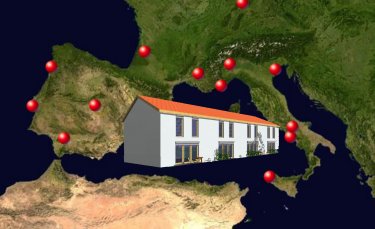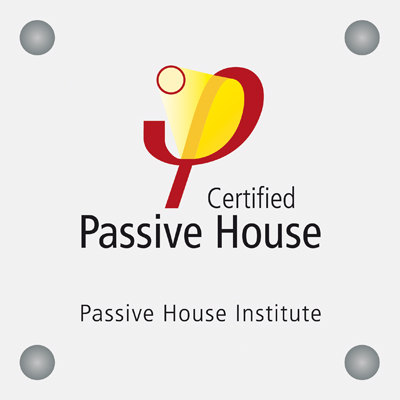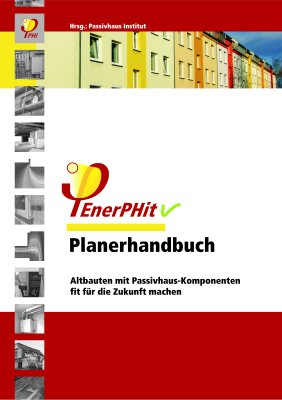Peer reviewed article:
Design and realisation of the Passive House concept in different climate zones - Schnieders et al
The article starts with a short introduction to the Passive House Standard. On the basis of nine examples of Passive Houses in the climate zones Canada, USA, Germany, China, Greece, Spain, Taiwan, Mexico and the United Arab Emirates the range of possible solutions is shown. Practical experience is available for many projects, which typically show high user satisfaction and low energy consumption, which corresponds very well with the requirements calculated in the planning tools. In some cases, a potential further improvment is described.
The article is available for free reading
Passive Houses for different climate zones
Passive House Institute and Rongen Architects have performed a research project dealing with Passive House and its specific requirements in different climate zones. Based on 5 locations representing different climate zones ranging from extremely cold to very hot and humid climates (Jekaterinburg, Tokyo, Shanghai, Las Vegas and Dubai), the project was aimed at identifying adequate technical solutions and analysing the impact of different parameters on a building's energy balance for each climate. Based on these findings, building examples fulfilling high architectural standards were developed for each of these locations. The project was rounded off by a global definition of the Passive House Standard, applicable for all climates.
The key findings of this project: No matter the location, Passive Houses can be built in a cost- effective way with regard to their life-cycle costs, although the concept of consistent heating and cooling load minimisation seems to reach its limits in extremely cold or hot regions.
The 500 page project report has been released in English and German and is available for purchase.
Shop
Energy Efficiency in the Mediterranean region with Passive Houses
 What does a Passive House in Palermo or Seville look like? Scientist Jürgen Schnieders discusses this in his dissertation on "Passive Houses in Mediterranean Climates? South West Europe??". According to this study, Passive Houses can also be realised in the Mediterranean region. The findings confirm that application of the Passive House concept is not just restricted to Germany and Austria, but can also contribute significantly towards reducing CO2 emissions globally.
What does a Passive House in Palermo or Seville look like? Scientist Jürgen Schnieders discusses this in his dissertation on "Passive Houses in Mediterranean Climates? South West Europe??". According to this study, Passive Houses can also be realised in the Mediterranean region. The findings confirm that application of the Passive House concept is not just restricted to Germany and Austria, but can also contribute significantly towards reducing CO2 emissions globally.
This study examines 12 locations in South West Europe (Italy, south France and the Iberian Peninsula). The climate in the Mediterranean region is characterised by higher temperatures, much more solar radiation and, to some extent, much higher air humidity than in the Central European region.
Given these climatic differences, the question arises whether the requirements for a Passive House can also be fulfilled in the Mediterranean region, and if so, how. Can Passive Houses offer the same high level of thermal comfort in the summer in this region as in Germany? Are they energy-efficient? Can they be heated, cooled or dehumidified via the supply air?
The study, which is in English, can be ordered here.
A summary of this study (in English) can be found here (![]() pdf 453 KB).
pdf 453 KB).
Source: Schnieders, Jürgen: Passive Houses in South West Europe. A quantitative investigation of some passive and active space conditioning techniques for highly energy efficient dwellings in the South West European region. 2nd corrected edition. Darmstadt, Passivhaus Institut, 2009.
Passive Houses in Chinese Climates
This study report of 114 pages systematically provides the basis for passive house design in all Chinese Climate zones, with the respects to e.g. the window quality, the insulation level, mechanical services and the building element construction. Different heating and/or cooling systems including the conventional mini-split are investigated in this study regarding to comfort, economy and availability. Special considerations on the construction types in climates "hot and humid summer" are at the same time investigated in this study. Besides, this report contains suggestions on how efficiency and building cost an be improved by suitable new components.
The study has been released in English and Chinese and is available for purchase.
Shop
| Next Courses |
PHPP Expert
Passive House Designer / Consultant
Construction Verifier
Site Supervisor
![]() read more
read more
e-learning
| Events |
iPHA Webinar "Project Spotlight: The CLT 8-floor ANMF hotel in Melbourne, Australia with heritage overlay." | November 12, 2025
![]() read more
read more
![]() Passive House Open Days |
Passive House Open Days |
7 - 9 November 2025
![]() read more
read more
![]() 24 - 25 April 2026, Essen, Germany
24 - 25 April 2026, Essen, Germany
![]() read more
read more
| Component Database |
 Passive House
Passive House
Component Database
read more
| Projects |
| New developments |
![]() designPH
designPH
read more
![]() NEW: PHPP 10 (2021)
NEW: PHPP 10 (2021)
read more
 Seals for Certified Passive House Components
Seals for Certified Passive House Components
read more
 Passive House Classes,
Passive House Classes,
Classic, Plus, Premium
read more
 EnerPHit -
EnerPHit -
PHI certification for retrofits
read more
 Wall plaque
Wall plaque
for certified Passive Houses
read more
| Press releases |
| Research & Literature |
![]() Passive Houses for different climate zones
Passive Houses for different climate zones
more
 Retrofits with Passive House components -
Retrofits with Passive House components -
EnerPHit Planner Handbook
(in German)
 Passive House Retail Stores now out
Passive House Retail Stores now out
Overview of contents
(in German)


